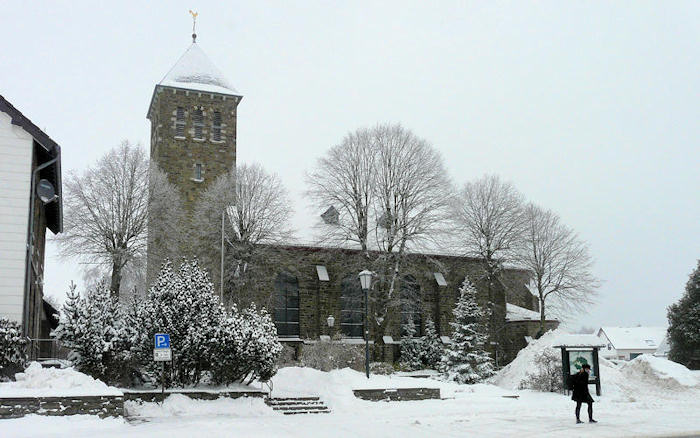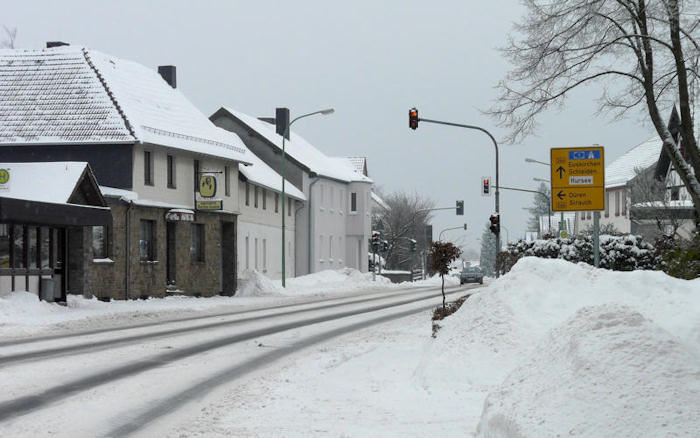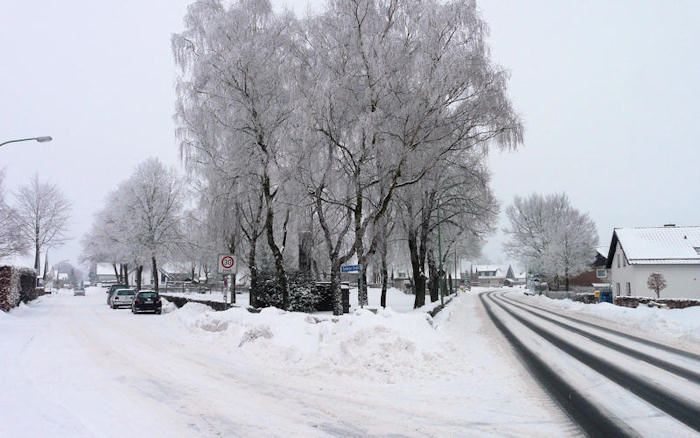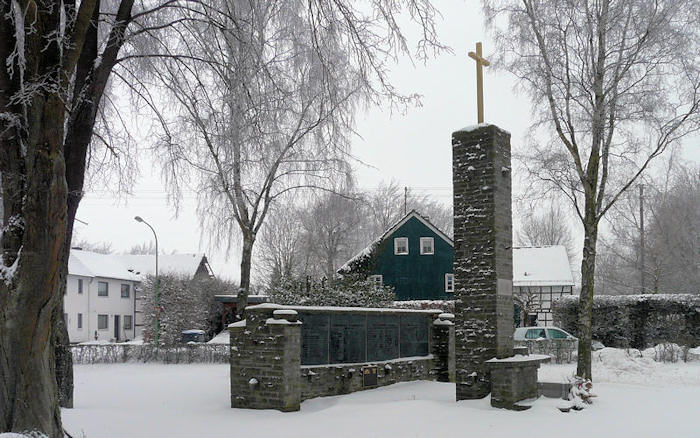in the Attack on Kesternich
30 January - 1 February 1945 - (Rhineland Campaign)
By Captain John H. Barner

THE SECOND DAY AND NIGHT IN KESTERNICH, 31 JANUARY
The Regimental Cannon Company was relieved from attachment to the 307th Field Artillery Battalion and displaced for- ward to SIMMERATH ' (¡3000 yards west of KESTERNICH) where it was ordered to render direct support to the 2d Battalion. Two forward observer parties remained with the 2d Battalion. 61 Twelve tanks were available. 62
Prior to the jump-off at 0830 hours it was observed that the enemy had laid new anti-tank mine fields during the night. These fields were hasty in nature and could be easily observed because they were not buried in the snow. A deceptive artillery preparation was fired at 0600 hours. At 0825 hour the five minute artillery preparation began to fall and upon its completion all elements started forward in the attack.
On the extreme north flank of the battalion the 1st Platoon of F Company started across the open fields toward Objective 26. Heavy flanking fire was received from buildings 44 and 45 thereby making it impossible to advance through the various hedgerows which crisscrossed the area. The Company Commander ordered the platoon to withdraw to the shelter of a hedgerow. The platoon took up positions in the sunken road running north along the eastern edge of Objective 24 and along the road, running north into the center of Objective 26. From these positions the platoon neutralized by fire the entire eastern portion of Objective 26. The 2d Platoon of F Company assaulted buildings 35, 36, and 40, which were captured after a brief fire fight. Meanwhile the 3d Platoon had captured building 41 and by 1130 hours both the 2d and 3d Platoons started an attack on buildings 43, 44, 45, and 51. These buildings were cleared after destroying six German machine guns and their crews; this marked the limit of F Company's advance for 31 January. 61 Twelve tanks were available. 63 The tank platoon supporting F Company had been in firing positions only twice throughout the entire day while the tank destroyer section had not fired a shot. The sunken roads, excessively deep snow, lack of training, and buildings hampered the movement of these supporting weapons.

The St. Peter and Paulus' church of Kesternich.

Road junction in the center of town.
To the south G Company had also pushed off at 0830 hours. It took the entire morning to maneuver into position, register mortar fire, and reduce the enemy positions in and around buildings 91 and 92. By noon the weather turned warm enough to thaw some of the snow. This resulted in soft slippery ground which was still covered with several inches of snow. As G Company pushed to the east from their newly won positions in buildings 91 and 92 they came under fire from enemy positions to the southeast. The company reported that this enemy position consisted of a pill box protected by field fortifications containing at least two machine guns. A tank destroyer moved forward to assist in the reduction of this pill box but it became stuck while trying to maneuver into position. G Company then requested the assistance of one tank however the tank reported that it was receiving direct fire from an anti-tank weapon and was unable to get into a firing position. 64
E Company's attack developed into the main effort for the day. During the night the enemy had established a main line of resistance not more than 150 yards forward of E Company's positions and at the same time occupied the buildings forward of their MLR. After clearing building 90, E Company started a slow methodical advance through these defenses. Supported by three tanks which advanced through prepared gaps in the anti-tank mine fields, the 1st and 3d Platoons penetrated this MLR. Each building became a separate fight with a fixed routine. The tanks would fire at a building until the wall was breached. E Company troops would make a dash for this hole, enter the building, and mop it up room by room. In at least two instances the Germans fired machine guns by manipulating wires which ran from one building to another. They had also made small firing embrasures by removing a single foundation block. This type of firing slot was difficult to locate.
E Company's attack was pushed with considerable vigor throughout the entire day. The former Executive Officer, now commanding the company, constantly moved with his assault echelons. This aggressiveness seemed to permeate the entire company as exemplified by Sergeant Jonah E. Kelley, a squad leader in the 1st Platoon who became particularly adept at reducing buildings with the aid of his squad. He would establish a base of fire and under cover of tills fire advance alone to the building being assaulted. He would then cover the advance of his squad. On one occasion his squad was held up by a machine gun which could not be neutralized by uaing the supporting tanks or other means. In a bold frontal assault Sergeant Kelly was able to kill four and wound one of the Germans in the emplacement. This was accomplished after he had been hit and knocked to the ground where he died as a result of his wounds. Sergeant Kelly was awarded the Medal of Honor for this action which permitted his squad to advance.
At about 1400 hours a tank was hit by a Panzerfaust in the vicinity of building 89. All platoons of E Company were low in strength and it was necessary to reinforce the 3d Platoon with a squad from the 2d Platoon. This enabled an advance to building 60. The remaining tank left with E Company lost its commander due to sniper fire; a sergeant from the 2d Platoon, E Company took command of the tank and coordinated its fire through the remainder of the day. 65
E Company continued to advance eastward from buildings 60 and 89. The large open area just forward of 60 presented some difficulty to this advance. Another tank was lost to an anti-tank mine between buildings 87 and 88. The Communication Sergeant became a casualty during the movement. Another main defensive line was breached at building 87. These advances coupled with G Company's previously described advance to buildings 91 and 92 resulted in the envelopment of several enemy positions which quickly surrendered when they received fire from the rear. A rapid questioning of these prisoners revealed the information that they had arrived as reinforcements at 0230 hours and had been ordered to hold their positions at all costs until a counterattack could be launched. These reinforcements had been hastily organized into an "Alarm" Company - the counterpart of our "temporary reserve" or "provisional" company. 66

The "triangle" and Memorial

Memorial for the fallen.

The "triangle" and the memorial at Kesternich.
Again it was necessary to reinforce the 3d Platoon with another squad from the 2d Platoon. The advance continued to the east and buildings 64, 65, 66, and 67 were cleared. 67 By 1200 hours the triangle at the eastern end of the town had been reached where buildings 84 and 67 were secured. At this time the 3d Platoon on the north side of the main street observed some "American" soldiers in the vicinity of building 68. A squad was moved across the open field between buildings 67 and 68 to join this group. As the squad moved across the open field the "Americans" fired upon them, wounding three men and causing the immediate withdrawal of the squad. Later Prisoner of War interrogation revealed that this enemy personnel had previously fought in the "bulge" where they had secured American uniforms. They were to have been part of the German counterattacking force in KESTERNICH.
The Battalion Commander moved his Observation Post to building 85 and contacted the E Company Commander in the ruins of building 84. After hearing his report the Battalion Commander decided that the time had arrived to commit his reserve tank platoon and launch a coordinated assault to drive the enemy from the town. The Tank Company Commander objected strenuously to this action for the reason that "no tanks would be left in reserve." The tanks were committed. 68 This final attack by E Company was planned to begin at 1315 hours, preceded by a five minute artillery preparation. 69 This preparation was planned to cover the area bounded by buildings 81, 82, 68 and 72. As the 2d Battalion Artillery Liaison Officer was arranging for this preparation the Division Artillery Commander radioed that Corps 8" artillery was available if it was desired; these fires were requested. Troops were warned to take cover during the artillery preparation which was laid on just 150 yards ahead of E Company's leading elements.
As the Division Artillery Commander entered KESTERNICH to observe this firing he stopped to secure information from the Cannon Company Commander who was moving along the main street near buildings 22 and 23.. A mortar concentration dispersed this group and wounded a driver. It appeared that German observation into the town was still effective. 70
At 1310 hours the five minute preparation began to fall in the area planned. It consisted of Corps 8" guns, three battalions of 155 Howitzers, and nine battalions of 105 Howitzers. In order to penetrate into the cellars it was fired by battalion, three volleys, with delayed fuse. 71 The supporting 4.2 Chemical Mortar Platoon and the 2d Battalion 81 mm mortars maintained a smoke screen on the extreme eastern edge of the town. 72 As the reserve platoon of tanks fanned out on either side of the triangle they adopted a line of columns formation with the two tank Section on the north and the three tank section on the south. With this formation only the lead tank in each section was able to fire to the front. E Company received a few casualties from short artillery rounds but prepared to move forward under the continued protection of the tank fire as the artillery preparation lifted.
In spite of this heavy preparation enemy small arms fire opened up immediately after the preparation ceased. Self-propelled 88 fire rained in on the triangle and casualties began to mount as a result of the ricochet bursts. This fire was ineffective against the tanks since the enemy gunners were firing "blind" through the smoke screen. Enemy mortar and artillery fire continued to fall and it was immediately apparent that the attack would bog down and fail unless the tanks moved forward and opened fire on obvious targets of opportunity which were presenting themselves along the line. However the tanks did not start moving forward and remained "buttoned up". The Tank Company Commander reported that his communication had failed again and that he had no control over the platoon. At this time the Battalion Commander and E Company Commander each mounted a tank and secured the crew's attention by covering the vision slots and pounding on the turrets with helmets. 73
When the tanks unbuttoned they were directed forward and targets were designated. This fire support enabled the capture of buildings 83 and 82 on the south side of the triangle and buildings 68, 69, and 70 to the north. 74
The second section of tank destroyers moved up the main street and stopped in column near building 85. Upon seeing these destroyers an excited E Company soldier ran to the Battalion Commander and reported that German tanks were attacking from the rear. One of the tankers also waved his arm to the rear and shouted "German Tanks". About this time a shell hit the building in which the battalion command group was located causing five casualties including the H Company Commander who was not evacuated. Upon checking with F and G Companies the Battalion Commander learned that neither company had observed enemy tanks in the rear of the battalion.
At 1600 hours the last buildings were being cleared by E Company which was working from south to north. The leading tank destroyer spotted some E Company men and fired one HE round into them, killing one man and wounding two others. The last tank in column on the south side of the triangle quickly spun his turret 180 degrees and fired one round at the tank destroyer at a range of 35 yards. Fortunately it was an HE round and did not harm the tank-destroyer. It did prompt the TD commander to stand up, level his finger at the tank and shout "That son-of-a-bitch shot at me." Mistaken identity was given as the cause for both of these errors. Everyone now realized that German tanks had not approached from the rear and the scare was over. 75
By 1630 hours buildings 71, 78, and 79 had been cleared. 76 During this action two platoon leaders were lost. A technical sergeant who had been leading his platoon forward for two days, and was credited with killing over 25 Germans, entered a building near 79 when a Panzerfaust exploded in the room with him, wounding four of his men. He went into hysteria— laughing while tears ran down his face. It was necessary to evacuate him for deafness and shock. The 2d Platoon leader who had been attacking to the northeast with F Company started forward to report to the E Company Commander that he had captured buildings 41 and 54. He was caught in a mortar concentration which resulted in his evacuation because of deafness and shock.
As E Company had been moving to the east, G Company was in the process of reducing the pill box previously reported. At 1400 hours the G Company Executive Officer reported to the Battalion Commander at the Battalion Observation Post (Building 85) that the G Company Commander's paralysis had now reached the point where he could no longer move around to any great extent. He was evacuated after an examination by the Battalion Surgeon, although he objected to this action. 77
With the former executive officer in Command, G Company proceeded to reduce the pill box. This was accomplished by placing smoke to the southeast of the pill box with 4.2 mortars, placing an 81mm mortar concentration on the objective, and moving in with marching fire. 78 Upon capture it was learned that this pill box consisted on nothing more than a stone ledge with positions dug in on and around it. G Company organized in place for the night. During the day of fighting the company had received casualties totaling fifteen wounded and evacuated plus an unknown number of men killed.
E Company outposted the last buildings captured but withdrew to a line between buildings 67 and 83 where they organized for the night. This withdrawal was necessary due to the presence of better fields of fire on this line and the lack of personnel in E Company. The enemy recovered building 78 by infiltration during the night.
K Company, 310th Infantry arrived in KESTERNICH and was attached to the 2d Battalion. By 1930 hours this company had relieved E Company which was assembled in battalion reserve in buildings 56 to 60. E Company had lost all of its platoon leaders and platoon Sergeants. Defensive positions were prepared to repel any counterattack from the northeast, the most likely avenue of approach. 79
Cannon Company had fired several missions in support of the various actions during the day. However due to the close quarters in which most of the fighting was conducted, it was impossible to give the fire support needed due to the normal dispersion of the M-3 Howitzer which was used by the Cannon Company. The company displaced forward during the day which also disrupted the fire support. 80
The battalion anti-tank platoon occupied positions in the eastern edge of the town during the night. The Battalion Command Post was located in building 85, the former Battalion Observation Post. Eight of the original fifteen supporting tanks remained operational for the next day's attack.
During the night the weather again turned bitter cold causing the water to freeze in foxholes. Trenchfoot and frostbite was prevalent however the Battalion Aid Station reported that only nine men were evacuated due to exposure. The hard fighting had welded the remaining men into a fighting unit with high esprit. Many of the men did not report the condition of their hands and feet, preferring to remain with their buddies on the line. 81

